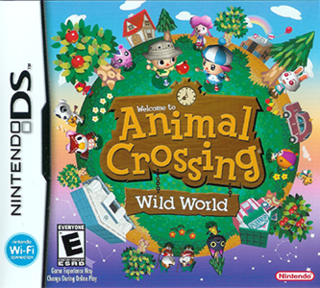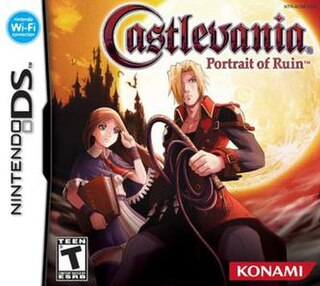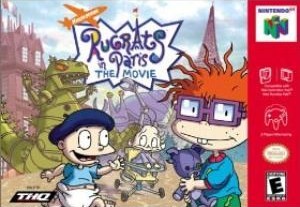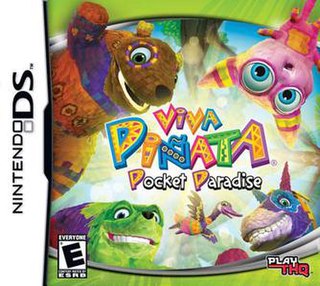
Animal Crossing: Wild World is a 2005 social simulation video game developed and published by Nintendo for the Nintendo DS handheld game console. It was released in Japan in November 2005, in North America and Australia in December 2005, and in Europe in March 2006. It is the second installment in the Animal Crossing series, and the sequel to Animal Crossing on the GameCube.

Super Mario 64 DS is a 2004 platform game developed and published by Nintendo for the Nintendo DS. It was a launch game for the DS. Super Mario 64 DS is a remake of the 1996 Nintendo 64 game Super Mario 64, with new graphics, characters, collectibles, a multiplayer mode, and several extra minigames. As with the original, the plot centers on rescuing Princess Peach from Bowser. Unlike the original, Yoshi is the first playable character, with Mario, Luigi, and Wario being unlockable characters in early phases of the game.

Pokémon Dash is a racing video game developed by Ambrella and published by The Pokémon Company and Nintendo for the Nintendo DS. It was a launch title both in Japan and Europe. Dash was released in Japan on December 2, 2004; Europe on March 11, 2005; North America on March 14, 2005; and Australia on April 7, 2005. It was the first Pokémon game to be released for the Nintendo DS.

Viewtiful Joe: Double Trouble!, known in Japan as Viewtiful Joe: Scratch!, is a video game developed by Clover Studio and published by Capcom for the Nintendo DS. It was released in 2005 in Japan and North America. Capcom partnered with Nintendo to distribute the game in Europe and Australia in early 2006. Viewtiful Joe: Double Trouble! is the fourth game released in the Viewtiful Joe series. The game's story opens on the set of director Captain Blue's new action movie in an amusement park called Movieland. When a mysterious group of villains known as Madow steal the only copy of the film, the superhero Viewtiful Joe and his younger sister Jasmine quickly give chase.

Trauma Center: Under the Knife is a simulation video game developed by Atlus for the Nintendo DS. The debut entry in the Trauma Center series, it was published in Japan and North America by Atlus in 2005, and by Nintendo in Europe in 2006. Set in a near future where medical science can cure previously incurable diseases, the world's population panics when a new manmade disease called GUILT begins to spread. Doctor Derek Stiles, a surgeon possessing a mystical "Healing Touch", works with the medical research organization Caduceus to find a cure to GUILT. The gameplay combines surgery-based simulation relying on the DS's touchscreen controls with a story told as a visual novel.

Pokémon Ranger is an action role-playing video game developed by HAL Laboratory and Creatures Inc. and published by The Pokémon Company and Nintendo for the Nintendo DS video game console. The game was released on various dates, varying between continents. The game was released in Japan on March 23, 2006, in North America and Australia during 2006, and in Europe in April 2007. It was released on the European Wii U Virtual Console on February 25, 2016.

Castlevania: Portrait of Ruin is a 2006 action role-playing game developed and published by Konami. The game was released on November 16, 2006 in Japan, and in North America on December 5, 2006 for the Nintendo DS handheld game console. Portrait of Ruin is the first Castlevania to feature a cooperative multiplayer gameplay mode and the first handheld Castlevania to have English voice-overs, outside of its original Japanese release.

Tetris DS is a puzzle video game developed and published by Nintendo. It was released for the Nintendo DS on March 20, 2006, in North America, April 13, 2006, in Australia, April 21, 2006, in Europe, and April 27, 2006, in Japan. An installment of the Tetris franchise, the game supports up to ten players locally, and supported online multiplayer of up to four players using Nintendo Wi-Fi Connection prior to its discontinuation.

Rugrats in Paris: The Movie is a video game based on the 2000 animated movie of the same name. The game follows the adventures of the Rugrats in a European theme park. A console version of the game was released in 2000, for the PlayStation, Nintendo 64, and a handheld version for Game Boy Color. A version for Microsoft Windows was later released in 2001. The console version's gameplay is similar to Rugrats: Studio Tour, but Paris’ attractions sometimes have minigames too. The handheld gameplay is a side-scrolling platformer. The Windows version's gameplay is an adventure game in which the player must find Chuckie's Wawa Bear.

Cars is a 2006 adventure racing game published by THQ. The game is based on the 2006 film of the same name. It was released for the PlayStation 2, GameCube, Xbox, Microsoft Windows, Game Boy Advance, Nintendo DS, and PlayStation Portable in June 2006, with versions for the Xbox 360 and Wii released later that year. The Wii version includes functionality geared towards its Wii Remote controller and was a launch game for the system. Taking place after the events of the film, the game follows Lightning McQueen as he participates in the new racing season with his goal set on finally winning the Piston Cup. While doing so, he races and trains with the local community of Radiator Springs.

Star Wars Episode I: Obi-Wan's Adventures is a video game that chronicles the events of the film Star Wars: Episode I – The Phantom Menace from the character Obi-Wan Kenobi's perspective. It is the result of an agreement made in 2000 between the two video game publishers LucasArts and THQ. The agreement allows THQ to turn LucasArts licenses into games for the hand held console Game Boy Color, the first being Obi-Wan's Adventures. THQ published the game and HotGen developed it. It was released on December 6, 2000.

Boogie is a music video game developed by Electronic Arts for the Wii, PlayStation 2 and Nintendo DS. Being touted as a party-game, it enables players to create their character, then use the Wii Remote and a microphone to sing and dance through it. Each song within the game can be performed either as a karaoke or as a dancing game. The game is based around an alien theme. It was one of the first games released in Brazil for the Wii. Although anticipation was high for the game, it received mixed reviews.

Viva Piñata: Pocket Paradise is a life simulation game developed by Rare, for the Nintendo DS video game console and based on Viva Piñata. Released days after Viva Piñata: Trouble in Paradise for the Xbox 360 in the fall of 2008, Pocket Paradise was developed by Rare's handheld team, as opposed to Viva Piñata: Party Animals and the PC version of the original game, which were developed by separate third-party developers. It was the final game Rare ever developed for a Nintendo system, as well as currently the final game in the series.

Castlevania Judgment is a 2008 fighting game developed by Eighting and published by Konami for the Wii. The game is based on the Castlevania series of games, and is the series' first fighting game.

WALL-E is a platform video game developed by Heavy Iron Studios and published by THQ, based on the 2008 film of the same name.

Lock's Quest is a real-time strategy tower defense video game developed by 5th Cell and published by THQ. It is 5th Cell's second Nintendo DS game. Players control Lock, a young man forced to help defend the kingdom of Antonia from an invasion of clockwork soldiers. The gameplay revolves around constructing defences such as walls and turrets on isometric battle maps, then controlling Lock to fight alongside and maintain his defences.

Guitar Hero: On Tour is a series of music video games based on the Guitar Hero series for the Nintendo DS handheld game system. The series is developed by Vicarious Visions and published by Activision. Three games in the series have been released since June 2008: Guitar Hero: On Tour, Guitar Hero On Tour: Decades, and Guitar Hero On Tour: Modern Hits.

Shin Megami Tensei: Strange Journey is a role-playing video game developed by Atlus and Lancarse for the Nintendo DS. The game is the sixth entry in the Shin Megami Tensei series, which forms the core of the Megami Tensei franchise. It was released in Japan in 2009, and in North America in 2010. An enhanced port for the Nintendo 3DS, Shin Megami Tensei: Strange Journey Redux, was released in Japan in 2017, and was released internationally in 2018 by Atlus in North America and Deep Silver in Europe.

Toy Story 3 is a 2010 platform game developed by Avalanche Software and published by Disney Interactive Studios. The game is based on the 2010 film of the same name. It was released for PlayStation 3, Xbox 360, Wii, and Microsoft Windows. The game was ported to Mac OS X by TransGaming. A Nintendo DS version was developed by n-Space, while Disney Mobile Studios developed and published an iOS game based on the film. Another version was developed by Asobo Studio and released for PlayStation 2 and PlayStation Portable.

Lufia: Curse of the Sinistrals, released as Estpolis: The Lands Cursed by the Gods (エストポリス) in Japan, is an action role-playing game video game co-developed by Neverland and Square Enix for the Nintendo DS. It is a remake of the 1995 Super Nintendo Entertainment System game Lufia II: Rise of the Sinistrals, also developed by Neverland. The character re-designs are by former Square Enix character designer, Yusuke Naora.





















